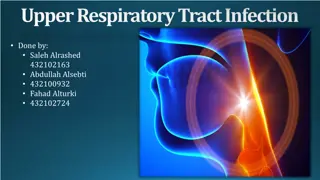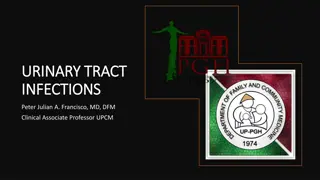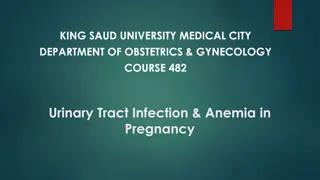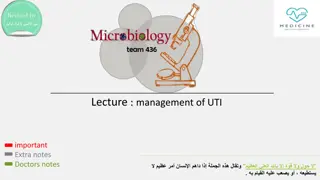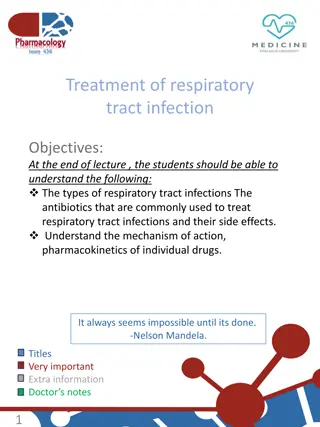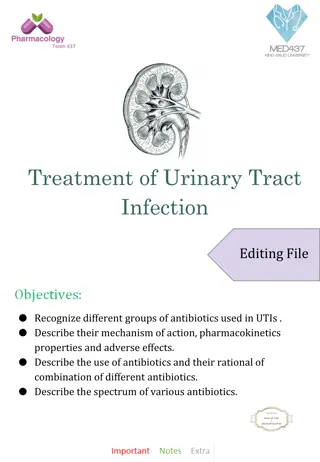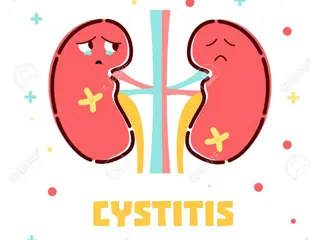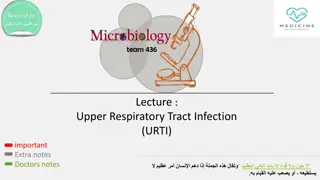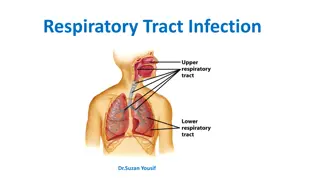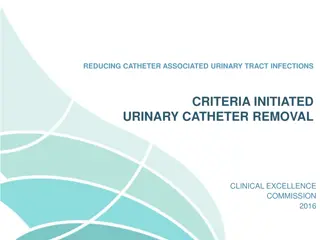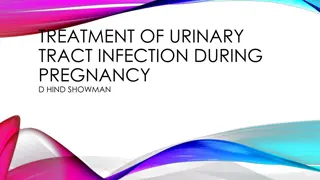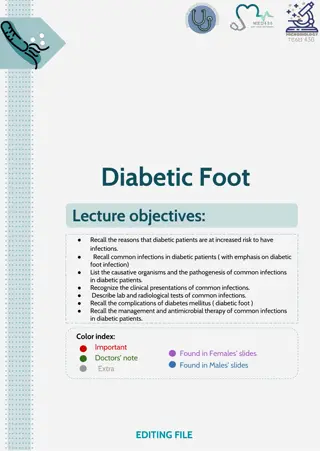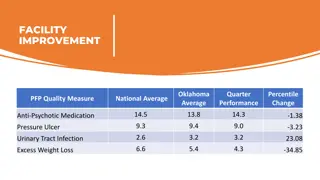Comprehensive Guide to Urinary Tract Infections: Symptoms, Treatment, and Prevention
This detailed guide covers urinary tract infections (UTIs) including symptoms in women, pregnant women, and men, risk factors like bacteriuria, management of recurrent UTIs, and treatment options. It emphasizes the importance of proper diagnosis, antibiotic therapy, and self-care practices for effective prevention and management of UTIs.
Download Presentation

Please find below an Image/Link to download the presentation.
The content on the website is provided AS IS for your information and personal use only. It may not be sold, licensed, or shared on other websites without obtaining consent from the author.If you encounter any issues during the download, it is possible that the publisher has removed the file from their server.
You are allowed to download the files provided on this website for personal or commercial use, subject to the condition that they are used lawfully. All files are the property of their respective owners.
The content on the website is provided AS IS for your information and personal use only. It may not be sold, licensed, or shared on other websites without obtaining consent from the author.
E N D
Presentation Transcript
Urinary Tract Infections Urinary Tract Infections Dr Paul Treon Clinical Director East Dunbartonshire HSCP GP Partner Kersland House Surgery, Milngavie
Urinary Tract Infections Urinary Tract Infections Bacteriuria Lower Urinary Tract Infection Women Pregnant Women Men Upper Urinary Tract Infection Sepsis Catheters Urine Testing FAQs
Bacteriuria Bacteriuria Risk of false positive cultures gold standard is needle aspiration of urine from bladder! first void v MSSU v catheter specimen Not a disease Common in >65 s, institutionalised women, long term indwelling catheters, sexually active & diabetes 6-7% of men and 16-17% of women >65 in Scotland Only treat if benefit out ways harm (e.g. pregnancy v elderly) 70-73% of non-pregnant women <50 with acute UTI sx have bacteriuria
Urinary Tract Infection Urinary Tract Infection non non- -pregnant women pregnant women Symptoms of LUTI FREQUENCY, DYSURIA, urgency, polyuria, suprapubic tenderness, frank haematuria, nocturia ~90% of healthy <65 with frequency and dysuria will have UTI Vaginal discharge/itch ?STI ?GP assessment ? NSAIDs/fluids Empirical (3d) treatment for healthy women with ??? (SIGN 88v160) Trimethoprim 200mg BD OR Nitrofurantoin 50mg QDS / 100mg BD (not if eGFR >30, caution 30-45) DO NOT treat asymptomatic non-pregnant women
Recurrent Urinary Tract Infection Recurrent Urinary Tract Infection - - Women Women 3+ in 12months or 2+ in 6mths Self care/advice re: hygiene hydration/voiding cranberry products note warfarin High strength capsules most effective (not men/catheterised) Post-menopausal women ?vaginal oestogen (not routinely) ?Post coital (trimethoprim / nitrofurantoin 100mg stat) Stand by Abx (3d course) Consider 3-6mths prophylactic Abx (trimethoprim 50mg nocte/ nitrofurantoin 100mg nocte)
Urinary Tract Infection Urinary Tract Infection pregnant women pregnant women MSSU for C&S before treatment starts and 7 days after completion Treat all symptomatic UTI & asymptomatic bacteriuria for 7days Abx of choice in GGC 1stLine Nitrofurantoin 50mg QDS / 100mg BD (1st/2ndtrimester only) 2ndLine Amoxicillin 500mg TDS (if susceptible) OR Cefelexin 500mg TDS
Urinary Tract Infection Urinary Tract Infection men men MSSU for C&S before treatment starts Treat all symptomatic UTI Empirical (7d) treatment Trimethoprim 200mg BD OR Nitrofurantoin 50mg QDS / 100mg BD (not if eGFR >30, caution 30-45) Consider prostatitis, epididymitis, chlamydia Recurrent / no response - ?prostatitis +/- refer urology
Upper Urinary Tract Infection Upper Urinary Tract Infection Symptoms of UUTI LUTI & low back/loin pain, fever, rigors, nausea/vomiting Empirical (7d) treatment Trimethoprim 200mg BD (if susceptible) [not in pregnancy] OR Co-amoxiclav 625mg TDS OR Ciprofloxacin 500mg BD (if true penicillin allergy) [Cefelexin 500mg BD in pregnancy] DO NOT forget sepsis severe life threatening systemic infection May need immediate GP review / admission or review and admit after 24hours
Sepsis Sepsis Age >75, impaired immunity, recent trauma/surgery, indwelling lines Likely infection source New altered mental state (delirium) Systolic BP <90mmHg (<100 then GP assessment) HR >130/min (>90 then GP assessment) RR >25/min (>21 then GP assessment) SpO2 >92% (88% in COPD) Skin changes (non-blanching rash, mottled, ashen, cyanotic Not passing urine (last 18hours)
Catheter Associated Urinary Tract Infection Catheter Associated Urinary Tract Infection Only treat if symptomatic, and send CSU for C&S pre-treatment DO NOT dip or routinely culture asymptomatic patients (false +ve) If catheter in situ for >7days then require catheter change No need for prophylactic Abx at routine catheter change unless history of catheter associated UTI / trauma Empirical (7d) treatment Nitrofurantoin 50mg QDS or 100mg BD OR Trimethoprim 200mg BD
Urine Tests Urine Tests Pharmacy Urine Collection tips: (Tayside) ?use of public toilets Double wrap (?stock of nappy bags) Test away from patient area (in case chatty patients) to read accurately Double bag and return to patients for disposal Appearance Turbidity (against bright background) Microscopy Wide variation and issues of health and safety at work
Urine Tests Urine Tests Urinalysis / dipstick (no benefit >65yrs of age) +ve if Leucocyte or Nitrites present (urine in bladder >4hrs) Sign 88 - indicated for women with minimal signs/symptoms of UTI (+ve dipstick & 1 symptom/sign = 80% likelihood of UTI) Sign 160 - ?Parallel to hx v following hx of 2+ sx Urine Culture (?diagnostic role in >65s) suprapubic aspirate or operatively obtained v clean catch, MSSU & CSU Testing for conventional aerobic bacteria >105cfu/ml (less for men) Single MSU reliable in 80% (2 +ve MSUs 95% reliable) Too many organisms suggests contamination C&S if failure to respond to 1stline or if indicated as previously The only test that can accurately guide ABx choice increases likelihood ratio
FAQs: FAQs: What do GPs do next .? What do GPs do next .? Children Need C&S as may need referral if atypical organism or recurrent >65s Can present with atypical symptoms Urinary sepsis may be more subtle (hypoactive delirium) But usually treat empirically (caution re: CKD/AKI) UUTI Higher risk of sepsis so should be clinically examined to rule out May need immediate admission for IV fluids/ABx. Strong worsening statement review +/- admission if not better at 24hrs
FAQs: FAQs: What do GPs do next .? What do GPs do next .? Diabetes High risk for sepsis & recurrence Check blood glucose control (acutely and in general) Sick day rules Risk of treatment failure May opt for MSSU for C&S to guide treatment May discuss risk factors or alternative diagnosis (STI, prostatitis) May discuss prophylactic treatments
FAQs: FAQs: What do GPs do next .? What do GPs do next .? Pregnancy / Breastfeeding Choice of antibiotic Treatment of asymptomatic bacteriuria Vaginal discharge / itch These are negatively predictive symptoms ?alternative treatments e.g. thrush / STI
Helpful Hints Helpful Hints Testing is not always the answer ?just treat Remember atypical symptoms and alternative diagnosis Remember women of child bearing age may be pregnant If in doubt refer to the GP Team Ask patient to bring a urine specimen to an appointment (just in case)
References References Sign Guideline 88 Management of Suspected Bacterial Urinary Tract Infection in Adults Sign Guideline 160 Management of Suspected Bacterial Lower Urinary Tract Infection in Adult Women NHS GG&C Clinical Guideline Infection Management in Adults, Primary Care Sepsis Trust Sepsis Screening Tool Community Nursing
Questions Questions



